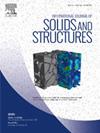Fatigue crack growth analysis based on energy parameters: A literature review
IF 3.4
3区 工程技术
Q1 MECHANICS
International Journal of Solids and Structures
Pub Date : 2025-03-24
DOI:10.1016/j.ijsolstr.2025.113355
引用次数: 0
Abstract
Fatigue crack growth (FCG) in metallic materials has been studied using non-linear parameters, which permit a better understanding of crack tip damage. The objective here is to make a literature review about the use of energy parameters in this context. Fundamental concepts are presented, namely the different types of energy that can be identified (the external work, the macroscopic elastic energy, the plastic dissipation, the internal potential energy and the thermal energy). FCG rate has been related with the dissipated energy measured externally, with the dissipated energy in the reversed plastic zone, with a punctual value of dissipated density energy at a critical location ahead of crack tip and with the thermal energy. The links between FCG mechanisms and energy parameters are exploited and guidelines for their use are proposed.
基于能量参数的疲劳裂纹扩展分析:文献综述
利用非线性参数对金属材料的疲劳裂纹扩展进行了研究,从而更好地理解裂纹尖端的损伤。本文的目的是对在这种情况下使用能量参数进行文献综述。提出了基本概念,即可以识别的不同类型的能量(外部功、宏观弹性能、塑性耗散、内部势能和热能)。FCG速率与外部测量的耗散能有关,与反向塑性区的耗散能有关,与裂纹尖端前关键位置的耗散密度能准时值有关,与热能有关。利用了FCG机制和能量参数之间的联系,并提出了使用指南。
本文章由计算机程序翻译,如有差异,请以英文原文为准。
求助全文
约1分钟内获得全文
求助全文
来源期刊
CiteScore
6.70
自引率
8.30%
发文量
405
审稿时长
70 days
期刊介绍:
The International Journal of Solids and Structures has as its objective the publication and dissemination of original research in Mechanics of Solids and Structures as a field of Applied Science and Engineering. It fosters thus the exchange of ideas among workers in different parts of the world and also among workers who emphasize different aspects of the foundations and applications of the field.
Standing as it does at the cross-roads of Materials Science, Life Sciences, Mathematics, Physics and Engineering Design, the Mechanics of Solids and Structures is experiencing considerable growth as a result of recent technological advances. The Journal, by providing an international medium of communication, is encouraging this growth and is encompassing all aspects of the field from the more classical problems of structural analysis to mechanics of solids continually interacting with other media and including fracture, flow, wave propagation, heat transfer, thermal effects in solids, optimum design methods, model analysis, structural topology and numerical techniques. Interest extends to both inorganic and organic solids and structures.

 求助内容:
求助内容: 应助结果提醒方式:
应助结果提醒方式:


